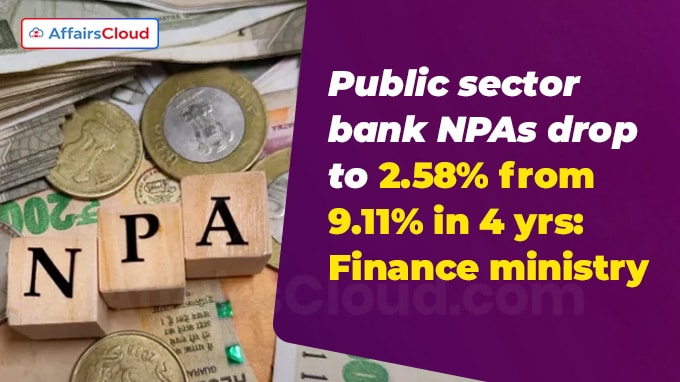 According to the Reserve Bank of India (RBI)’s provisional data which showed that Gross Non-Performing Assets (GNPA) of Public Sector Banks (PSBs) has steadily decreased over the last 5 years i.e. from 9.11%(6.16 lakh crore) in Financial Year 2020-21 (FY21) to 2.58%(Rs.2.83 lakh crore) in FY25.
According to the Reserve Bank of India (RBI)’s provisional data which showed that Gross Non-Performing Assets (GNPA) of Public Sector Banks (PSBs) has steadily decreased over the last 5 years i.e. from 9.11%(6.16 lakh crore) in Financial Year 2020-21 (FY21) to 2.58%(Rs.2.83 lakh crore) in FY25.
- He also highlighted that this decline in GNPAs was mainly attributed by joint measures initiated by the Government of India (GoI) and the RBI.
- This data was shared by Union Minister of State(MoS) Pankaj Chaudhary, Ministry of Finance(MoF), in a written response to a question in the Rajya Sabha.
Key Findings:
i.As per RBI’s data, PSBs witnessed sharp decline in their GNPAs, mainly due to the Insolvency and Bankruptcy Code (IBC) that could remove non-payers from the company’s management and bar wilful defaulters from participating in the resolution process.
ii.Timely identification of potential defaults has helped reduce the fresh addition of NPAs by PSBs to below 1% of their standard advances, a sharp decline from 8.35% in March 2018.
iii.With the joint efforts of the Government of India(GoI) and the RBI, GNPA of Scheduled Commercial Banks (SCBs), including PSBs, declined from Rs 10.36 lakh crore (as of March 31, 2018) to Rs 4.45 lakh crore (in December 2024).
Key Measures led to Decline in GNPAs:
i.Following the enactment of IBC in 2016, the code has rescued 3,171 distressed companies involving 1,119 cases, recovering Rs 3.6 lakh crore (as on December 31, 2024) as compared to Board of Industrial and Financial Reconstruction (BIFR) regime that resolved less than 3,500 cases in about 30 years since its inception in 1987.
ii.Amendments to existing laws such as the Securitisation and Reconstruction of Financial Assets and Enforcement of Security Interest (SARFAESI) Act, 2002 and the Recovery of Debts and Bankruptcy Act, 1993 (RDB Act) have helped in the faster recovery of bad loans.
iii.The GoI also raised the financial threshold for cases handled by Debt Recovery Tribunals (DRTs) from Rs 10 lakh to Rs 20 lakh, thereby enhancing recovery for banks and financial institutions.
iv.PSBs have established specialized stressed assets management verticals and branches for effective monitoring and follow-up of NPA accounts, which ensures faster and enhanced resolution and recoveries.
- PSBs have further initiated measures like: deployment of business correspondents and adoption of the ‘Feet-on-Street’ model have also supported the recovery trajectory of NPAs in banks.
v.RBI mandated practices which PSBs are required to follow regarding asset valuation such as: it is mandatory for banks to follow board-approved policies for property valuation, conducted by independent qualified valuers.
- Also, for assets worth Rs 50 crore or more, minimum two independent valuation reports must be obtained to ensure transparency.
Important Terms:
- Non-Performing Assets (NPAs): Loans on which borrowers have failed to repay principal or interest for 90 days, causing a loss of income for lenders.
- Gross Non-Performing Assets (GNPA): It refers to the total value of loans that have turned non-performing. GNPA is reported as an absolute figure.
- GNPA Ratio: It refers to the ratio of gross NPAs to their total advances in a particular year.




